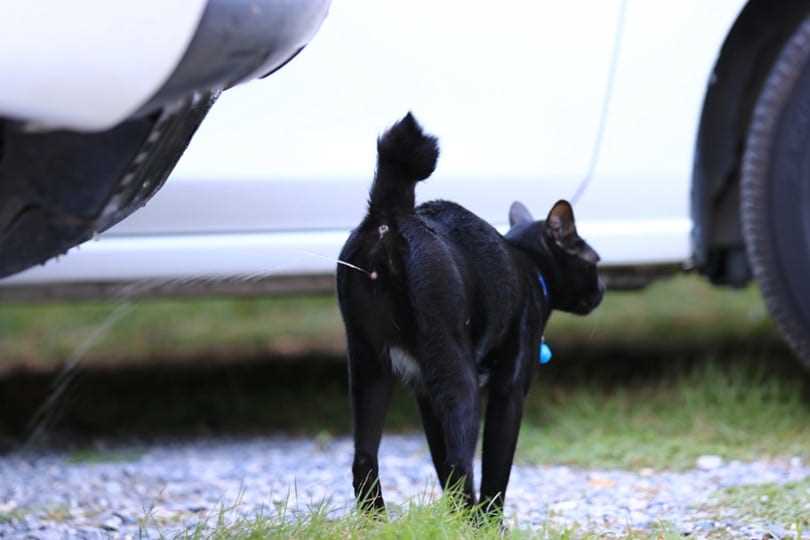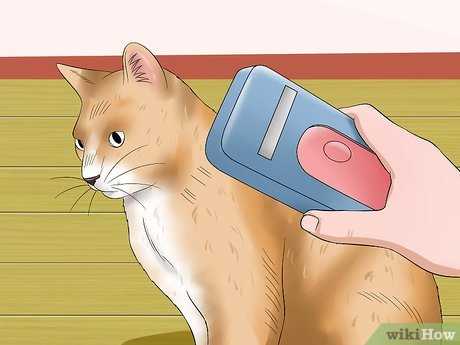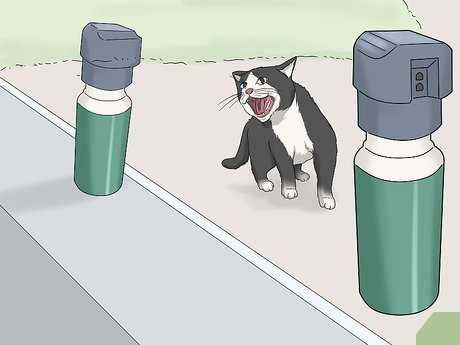



Utilizing natural deterrents like citrus peels or vinegar can significantly reduce unwanted territory marking in outdoor areas. These scents are generally unpleasant to many felines and may encourage them to seek alternatives.
Creating a designated area with comfortable shelter and food can redirect attention away from your property. This strategy helps in establishing a safe space that becomes more appealing than your surroundings.
Regularly cleaning any existing markings with enzymatic cleaners ensures that lingering scents do not invite further issues. Products specifically designed to eliminate odors are most effective, as they break down the compounds that attract returning animals.
Installing motion-activated sprinklers can provide a surprising deterrent. The sudden burst of water typically encourages animals to steer clear, making your environment less inviting for unwanted visitors.
Engaging in community programs aimed at responsible pet ownership can also make a difference. Supporting local initiatives focused on spaying and neutering can lead to a decrease in the local feline population, thereby reducing territorial behaviors.
Effective Strategies for Deterring Unwanted Marking
Utilizing natural deterrents can significantly reduce unwanted behaviors in felines. Try sprinkling citrus peels or using essential oils like lavender or eucalyptus in outdoor areas. These scents are often unappealing to many four-legged visitors.
Creating a Less Inviting Environment
Removing food and shelter sources is crucial. Ensure that trash bins are securely closed and any pet food is not left outside. Additionally, consider using motion-activated sprinklers or lights to startle any intruders. Cats dislike sudden movements or unexpected noise, making your space less attractive to them.
Understanding Their Needs
Sometimes, understanding what motivates these animals can lead to better solutions. For example, if you’re curious about what do snowshoe cats eat, it might help you determine what food sources could be attracting them. Additionally, if you’re introducing a new feline to your home, knowing how long should i wait to introduce my cats can aid in reducing territorial behavior, which might contribute to marking issues.
Understanding the Reasons Behind Spraying Behavior

Recognizing territory is a prime reason for marking. When unfamiliar felines enter my domain, I need to assert ownership. It’s instinctual–like a stamp claiming my space. The scent left behind communicates to others that this territory is mine.
Stress and anxiety play significant roles too. Changes, such as new pets or moving, can trigger this response. I might feel threatened or unsettled, prompting me to mark my surroundings as a way to cope with discomfort.
Health Factors
Underlying health issues may also contribute. Conditions like urinary tract infections can lead to inappropriate elimination. It’s vital to ensure that any feline friend is regularly checked by a vet to rule out medical problems.
Sexual Behavior
Unaltered males and females are especially prone to marking as part of their mating behavior. Neutering or spaying can significantly reduce this instinct, promoting a more peaceful environment for everyone involved.
Implementing Environmental Changes to Deter Stray Cats

Creating barriers can significantly reduce unwanted visits. Consider installing fences or planting dense shrubs to obstruct access to your space. Use materials that deter climbing, such as prickly plants or thorny bushes.
Alter feeding habits of local wildlife to discourage feline visitors. Secure trash bins with tight lids, and avoid leaving pet food outside. Clean up any spills or crumbs promptly to eliminate enticing scents.
Utilize scent deterrents. Citrus peels, vinegar, or commercial repellents can be scattered or sprayed in areas where unwelcome visitors frequent. Cats often dislike strong odors, making this a useful strategy.
Enhance the outdoor environment. Install motion-activated sprinklers. The sudden burst of water can frighten away intruders effectively. Additionally, consider using ultrasonic deterrents that emit sounds unpleasant to felines but inaudible to humans.
- Secure fences or walls to prevent entry.
- Plant dense foliage to create natural barriers.
- Use citrus peels and vinegar as scent deterrents.
- Implement motion-activated sprinklers.
- Consider ultrasonic devices for added protection.
Regular maintenance of the yard is key. Keep the area tidy and free of debris where cats might hide. This discourages them from lingering, ensuring a more peaceful environment.
Utilizing Deterrents and Repellents to Protect Your Property

Consider using citrus-based sprays. The scent of oranges and lemons is often disliked by felines, making it a natural repellent. Spritz diluted citrus oil around areas where unwanted visitors tend to mark their territory.
Another option is vinegar. This strong-smelling liquid can deter many animals. Mix equal parts of water and vinegar and apply it to surfaces. The pungent aroma can discourage approach.
Granulated garlic is also useful. Spreading it around your yard can create an unwelcoming environment. Most animals steer clear of its odor.
Motion-activated sprinklers provide a surprising deterrent. When something approaches, they spray water, which can startle and send any intruders running.
Ultrasonic devices emit a high-frequency sound that irritates sensitive ears. These are effective at keeping furry visitors at bay without harming them.
Using physical barriers, like fences topped with spikes or roller bars, can also help. These structures make it challenging for animals to enter specific areas.
Lastly, natural predators can be a great deterrent. If you’re comfortable, consider introducing a dog that barks at intruders. The presence of a larger animal can be enough to keep unwanted visitors away.
Utilizing natural deterrents like citrus peels or vinegar can significantly reduce unwanted territory marking in outdoor areas. These scents are generally unpleasant to many felines and may encourage them to seek alternatives.
Creating a designated area with comfortable shelter and food can redirect attention away from your property. This strategy helps in establishing a safe space that becomes more appealing than your surroundings.
Regularly cleaning any existing markings with enzymatic cleaners ensures that lingering scents do not invite further issues. Products specifically designed to eliminate odors are most effective, as they break down the compounds that attract returning animals.
Installing motion-activated sprinklers can provide a surprising deterrent. The sudden burst of water typically encourages animals to steer clear, making your environment less inviting for unwanted visitors.
Engaging in community programs aimed at responsible pet ownership can also make a difference. Supporting local initiatives focused on spaying and neutering can lead to a decrease in the local feline population, thereby reducing territorial behaviors.
Effective Strategies for Deterring Unwanted Marking
Utilizing natural deterrents can significantly reduce unwanted behaviors in felines. Try sprinkling citrus peels or using essential oils like lavender or eucalyptus in outdoor areas. These scents are often unappealing to many four-legged visitors.
Creating a Less Inviting Environment
Removing food and shelter sources is crucial. Ensure that trash bins are securely closed and any pet food is not left outside. Additionally, consider using motion-activated sprinklers or lights to startle any intruders. Cats dislike sudden movements or unexpected noise, making your space less attractive to them.
Understanding Their Needs
Sometimes, understanding what motivates these animals can lead to better solutions. For example, if you’re curious about what do snowshoe cats eat, it might help you determine what food sources could be attracting them. Additionally, if you’re introducing a new feline to your home, knowing how long should i wait to introduce my cats can aid in reducing territorial behavior, which might contribute to marking issues.
Understanding the Reasons Behind Spraying Behavior

Recognizing territory is a prime reason for marking. When unfamiliar felines enter my domain, I need to assert ownership. It’s instinctual–like a stamp claiming my space. The scent left behind communicates to others that this territory is mine.
Stress and anxiety play significant roles too. Changes, such as new pets or moving, can trigger this response. I might feel threatened or unsettled, prompting me to mark my surroundings as a way to cope with discomfort.
Health Factors
Underlying health issues may also contribute. Conditions like urinary tract infections can lead to inappropriate elimination. It’s vital to ensure that any feline friend is regularly checked by a vet to rule out medical problems.
Sexual Behavior
Unaltered males and females are especially prone to marking as part of their mating behavior. Neutering or spaying can significantly reduce this instinct, promoting a more peaceful environment for everyone involved.
Implementing Environmental Changes to Deter Stray Cats

Creating barriers can significantly reduce unwanted visits. Consider installing fences or planting dense shrubs to obstruct access to your space. Use materials that deter climbing, such as prickly plants or thorny bushes.
Alter feeding habits of local wildlife to discourage feline visitors. Secure trash bins with tight lids, and avoid leaving pet food outside. Clean up any spills or crumbs promptly to eliminate enticing scents.
Utilize scent deterrents. Citrus peels, vinegar, or commercial repellents can be scattered or sprayed in areas where unwelcome visitors frequent. Cats often dislike strong odors, making this a useful strategy.
Enhance the outdoor environment. Install motion-activated sprinklers. The sudden burst of water can frighten away intruders effectively. Additionally, consider using ultrasonic deterrents that emit sounds unpleasant to felines but inaudible to humans.
- Secure fences or walls to prevent entry.
- Plant dense foliage to create natural barriers.
- Use citrus peels and vinegar as scent deterrents.
- Implement motion-activated sprinklers.
- Consider ultrasonic devices for added protection.
Regular maintenance of the yard is key. Keep the area tidy and free of debris where cats might hide. This discourages them from lingering, ensuring a more peaceful environment.
Utilizing Deterrents and Repellents to Protect Your Property

Consider using citrus-based sprays. The scent of oranges and lemons is often disliked by felines, making it a natural repellent. Spritz diluted citrus oil around areas where unwanted visitors tend to mark their territory.
Another option is vinegar. This strong-smelling liquid can deter many animals. Mix equal parts of water and vinegar and apply it to surfaces. The pungent aroma can discourage approach.
Granulated garlic is also useful. Spreading it around your yard can create an unwelcoming environment. Most animals steer clear of its odor.
Motion-activated sprinklers provide a surprising deterrent. When something approaches, they spray water, which can startle and send any intruders running.
Ultrasonic devices emit a high-frequency sound that irritates sensitive ears. These are effective at keeping furry visitors at bay without harming them.
Using physical barriers, like fences topped with spikes or roller bars, can also help. These structures make it challenging for animals to enter specific areas.
Lastly, natural predators can be a great deterrent. If you’re comfortable, consider introducing a dog that barks at intruders. The presence of a larger animal can be enough to keep unwanted visitors away.
Utilizing natural deterrents like citrus peels or vinegar can significantly reduce unwanted territory marking in outdoor areas. These scents are generally unpleasant to many felines and may encourage them to seek alternatives.
Creating a designated area with comfortable shelter and food can redirect attention away from your property. This strategy helps in establishing a safe space that becomes more appealing than your surroundings.
Regularly cleaning any existing markings with enzymatic cleaners ensures that lingering scents do not invite further issues. Products specifically designed to eliminate odors are most effective, as they break down the compounds that attract returning animals.
Installing motion-activated sprinklers can provide a surprising deterrent. The sudden burst of water typically encourages animals to steer clear, making your environment less inviting for unwanted visitors.
Engaging in community programs aimed at responsible pet ownership can also make a difference. Supporting local initiatives focused on spaying and neutering can lead to a decrease in the local feline population, thereby reducing territorial behaviors.
Effective Strategies for Deterring Unwanted Marking
Utilizing natural deterrents can significantly reduce unwanted behaviors in felines. Try sprinkling citrus peels or using essential oils like lavender or eucalyptus in outdoor areas. These scents are often unappealing to many four-legged visitors.
Creating a Less Inviting Environment
Removing food and shelter sources is crucial. Ensure that trash bins are securely closed and any pet food is not left outside. Additionally, consider using motion-activated sprinklers or lights to startle any intruders. Cats dislike sudden movements or unexpected noise, making your space less attractive to them.
Understanding Their Needs
Sometimes, understanding what motivates these animals can lead to better solutions. For example, if you’re curious about what do snowshoe cats eat, it might help you determine what food sources could be attracting them. Additionally, if you’re introducing a new feline to your home, knowing how long should i wait to introduce my cats can aid in reducing territorial behavior, which might contribute to marking issues.
Understanding the Reasons Behind Spraying Behavior

Recognizing territory is a prime reason for marking. When unfamiliar felines enter my domain, I need to assert ownership. It’s instinctual–like a stamp claiming my space. The scent left behind communicates to others that this territory is mine.
Stress and anxiety play significant roles too. Changes, such as new pets or moving, can trigger this response. I might feel threatened or unsettled, prompting me to mark my surroundings as a way to cope with discomfort.
Health Factors
Underlying health issues may also contribute. Conditions like urinary tract infections can lead to inappropriate elimination. It’s vital to ensure that any feline friend is regularly checked by a vet to rule out medical problems.
Sexual Behavior
Unaltered males and females are especially prone to marking as part of their mating behavior. Neutering or spaying can significantly reduce this instinct, promoting a more peaceful environment for everyone involved.
Implementing Environmental Changes to Deter Stray Cats

Creating barriers can significantly reduce unwanted visits. Consider installing fences or planting dense shrubs to obstruct access to your space. Use materials that deter climbing, such as prickly plants or thorny bushes.
Alter feeding habits of local wildlife to discourage feline visitors. Secure trash bins with tight lids, and avoid leaving pet food outside. Clean up any spills or crumbs promptly to eliminate enticing scents.
Utilize scent deterrents. Citrus peels, vinegar, or commercial repellents can be scattered or sprayed in areas where unwelcome visitors frequent. Cats often dislike strong odors, making this a useful strategy.
Enhance the outdoor environment. Install motion-activated sprinklers. The sudden burst of water can frighten away intruders effectively. Additionally, consider using ultrasonic deterrents that emit sounds unpleasant to felines but inaudible to humans.
- Secure fences or walls to prevent entry.
- Plant dense foliage to create natural barriers.
- Use citrus peels and vinegar as scent deterrents.
- Implement motion-activated sprinklers.
- Consider ultrasonic devices for added protection.
Regular maintenance of the yard is key. Keep the area tidy and free of debris where cats might hide. This discourages them from lingering, ensuring a more peaceful environment.
Utilizing Deterrents and Repellents to Protect Your Property

Consider using citrus-based sprays. The scent of oranges and lemons is often disliked by felines, making it a natural repellent. Spritz diluted citrus oil around areas where unwanted visitors tend to mark their territory.
Another option is vinegar. This strong-smelling liquid can deter many animals. Mix equal parts of water and vinegar and apply it to surfaces. The pungent aroma can discourage approach.
Granulated garlic is also useful. Spreading it around your yard can create an unwelcoming environment. Most animals steer clear of its odor.
Motion-activated sprinklers provide a surprising deterrent. When something approaches, they spray water, which can startle and send any intruders running.
Ultrasonic devices emit a high-frequency sound that irritates sensitive ears. These are effective at keeping furry visitors at bay without harming them.
Using physical barriers, like fences topped with spikes or roller bars, can also help. These structures make it challenging for animals to enter specific areas.
Lastly, natural predators can be a great deterrent. If you’re comfortable, consider introducing a dog that barks at intruders. The presence of a larger animal can be enough to keep unwanted visitors away.











